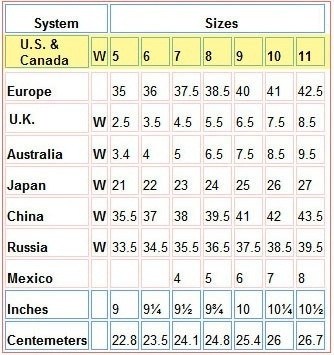Converting Chinese Shoe Size to AUS: A Parent’s Ultimate Guide
Welcome to the world of shoe shopping, where the quest to find the perfect pair often leads you down the path of international size conversions! It’s no secret that children’s feet grow at the speed of light, making shoe-buying a frequent activity for parents.
If you’ve fallen in love with a pair of shoes for your little one that’s based in Chinese sizing, never fear! Our all-encompassing guide to converting Chinese shoe size to AUS will have you shopping like a pro in no time.
Understanding Shoe Sizing Differences
First things first, it’s important to grasp why shoe sizes vary from country to country. Every nation has its own method of measuring foot length and width, and often, the same numerical size can mean something quite different in another sizing standard. Confusing? Absolutely. But that’s why we’re here to streamline the process!
Chinese Shoe Size Chart Explained
Chinese shoe sizes for kids utilise a different scaling system compared to Australian sizes. In China, the system is usually measured in millimetres (mm) or based on the length of the shoe’s inner cavity, which can be tricky to line up with the Aussie system, which uses UK sizes as its basis.
But fret not — by understanding the conversion between these two systems, you can confidently select shoes that will provide a snug, comfortable fit for your child.
Step-by-Step Conversion
Let’s break down the conversion process into simple steps that you can follow. Don’t worry, you won’t need a math degree — just this guide and perhaps a handy shoe size conversion chart, which we’ll provide.
Measure Your Child’s Feet
The foundation of any size conversion is the accurate measurement of your child’s feet. You can do this at home using a ruler or measuring tape — make sure to measure both feet in millimetres as one can be slightly bigger than the other. Always use the larger size when making conversions to ensure maximum comfort.
Convert Millimetres to Chinese Sizes
Once you have your child’s foot measurements, use these figures to find the corresponding Chinese shoe size. For example, if your child’s foot measures 150mm, you’d start by looking for this measurement on the Chinese shoe size chart.
Match Chinese Sizes to Australian Sizes
After identifying the Chinese size, the next step is to find the equivalent Australian size. This is where the conversion chart comes into play. We’ve included an easy-to-use table that correlates Chinese to Australian kids’ shoe sizes, making your shopping experience hassle-free.
Now that you have the basics, keep reading as we delve into more detailed conversion tables and practical tips for ensuring the ideal fit every time you shop for shoes.
Chinese to AUS Shoe Size Conversion Table
Below is a simplified conversion table to help you navigate from Chinese shoe sizes to AUS for children:
- Chinese Size 15 – AUS Size 2.5
- Chinese Size 16 – AUS Size 3
- Chinese Size 17 – AUS Size 3.5
Keep this table bookmarked or print it out for quick reference whenever you find an adorable pair of shoes online or on your travels. But remember, this is just a starting point; personal fit preferences and specific brand sizings can also impact the perfect size selection.
Shopping for your child’s shoes can be a joyful experience when armed with the right information. As you continue through this guide, remember that the comfort and happiness of your child’s tiny toes are what matters at the end of the day. Stay tuned as we discuss how to adjust for different shoe styles and the best practices for online shoe shopping for kids.
In our next section, we’ll cover everything from the nuances of choosing the best shoes for your children’s active lifestyles to understanding how different brands may size their footwear. With this guide, you’ll be converting Chinese shoe sizes to AUS like a seasoned expert!

5 Things Parents Should Know When Preparing for Chinese Shoe Size to AUS Conversion
Before we dive into conversion details, let’s highlight five essential things every parent should know to ensure their little one’s feet are not only stylish but also comfortable.
1. Measure Regularly and Update Size Accordingly
Children’s feet grow quickly – sometimes they may need new shoes every few months. Remember to measure your child’s feet regularly, especially before ordering a new pair to account for any size changes that might have occurred.
2. Account for Sock Thickness
When measuring and subsequently purchasing shoes, consider the thickness of the socks your child will typically wear with the shoes. Thick socks can affect the fit, so aim for a slightly larger size to accommodate them.
3. Understand the Importance of Wiggle Room
It’s essential for kids’ shoes to provide enough room for toes to wiggle. Approximately 10-12mm of space beyond the longest toe is recommended to ensure comfort and allow for growth.
4. Be Aware of Brand-Specific Sizing
Even with a conversion chart, it’s important to be aware that some brands may have their own unique sizing. Look for specific size guides or customer reviews for the brand you’re interested in to get a better idea of fit.
5. Check for Return Policies
When ordering shoes from international brands, it’s wise to check the return policy in case the size isn’t quite right. Ensuring you can exchange or return shoes without a hassle will make the shopping experience much less stressful.
Now that we’ve armed you with these foundational tips, you’re ready to tackle Chinese shoe size conversion with the confidence of a pro. In our upcoming sections, we’ll present detailed conversion charts, factors to keep in mind for different shoe styles, and smart strategies for navigating online shoe shopping. Ready to have some fun and find the perfect fit for your child? Let’s dive deeper into our ultimate guide to Chinese shoe size conversion!
Detailed Conversion Accuracy Tips
To ensure precision when converting sizes, follow these accuracy tips:
- Always check the date when the conversion chart was last updated, as sizes and standards may change over time.
- If possible, compare multiple conversion charts to confirm consistency.
- Look for size conversion tools provided by reputable shoe retailers or manufacturers.
- When in doubt, contact customer service for the brand you’re interested in to ask for their sizing advice.
- Consider a professional fitting if you have concerns about the fit, particularly for specialty shoes such as sports or orthopedic footwear.
Armed with these tips and the knowledge provided in this guide, you’ll be ready to pick out the most adorable and comfortable shoes for your child, no matter where they’re from. Happy shoe hunting!
For more great articles please see here. For more information see here
Disclaimer
The articles available via our website provide general information only and we strongly urge readers to exercise caution and conduct their own thorough research and fact-checking. The information presented should not be taken as absolute truth, and, to the maximum extent permitted by law, we will not be held liable for any inaccuracies or errors in the content. It is essential for individuals to independently verify and validate the information before making any decisions or taking any actions based on the articles.




